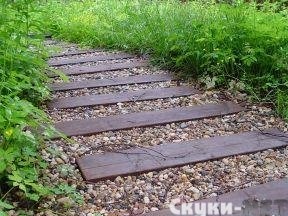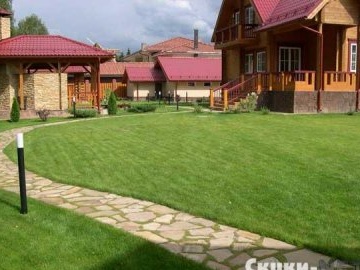
Paths in the garden are not just a trajectory of movement. In addition to the utilitarian role, they also play the most important aesthetic, being one of the main elements of the site design. Therefore, the choice of tracks is a responsible matter. They should be convenient, practical, and fit into the overall style of your garden. To consider the location of the tracks is at the initial stage of landscaping. Walk around the future garden, estimate the places of the greatest attendance, convenient routes to them, what will be the views on the sides of the path, where there will be a bench, a gazebo. Perhaps there will be plants requiring increased attention on the site, the path should lead to the place of their growth.
Having decided on the layout, you should deal with the materials from which the track will be made. The choice is very rich.
Artificial materials
The most common option is artificial materials: asphalt, concrete, paving slabs. Concrete tiles vary in thickness, shape, color, surface texture, imitation of natural materials is possible. Concrete is resistant to light, temperature extremes, aggressive compounds. Recently, plastic has been added to the list of artificial materials, assembled according to the principle of a children's designer. This material is durable, mobile, it can be laid on the playground or on top of the lawn.
A natural stone
One of the best materials for creating tracks is natural stone. It is usually applied in the form of a flagstone, but with success is used in the form of "wild" cobblestones or whetstones. A variety of shapes and textures, many shades make it possible to use stone, both in large gardens and in areas of small area. The most expensive types of stone are marble, granite, basalt, porphyry. Varieties are cheaper - sandstone and limestone.
Wooden walkways
Wooden paths set a special tone in any landscape. This material is considered warm, sincere, natural. It is used in the form of circularly sawn round logs deepened into the ground, solid blocks, and sometimes - mulch bark or sawdust in bulk paths.Of course, wooden paths are short-lived and moody, but in some styles they are simply irreplaceable.
Brick brick
An excellent material for creating paths is clinker brick. Durable, frost-resistant, the path from it can be made in the form of a braid, Christmas tree, brick, perpendicular or bandaged rows.
Crushed stone, gravel, pebbles, sand
Bulk paths are a fairly inexpensive option. It is important that the pebbles are not too large, otherwise the track will turn out uncomfortable. And on the sidelines you will have to take care of the mount.
Pebble mosaic walkway
This kind of track has not yet become widespread in landscape design, since laying mosaics is very difficult, it requires experience, skills and creativity. Such tracks are expensive, but are considered very prestigious.

